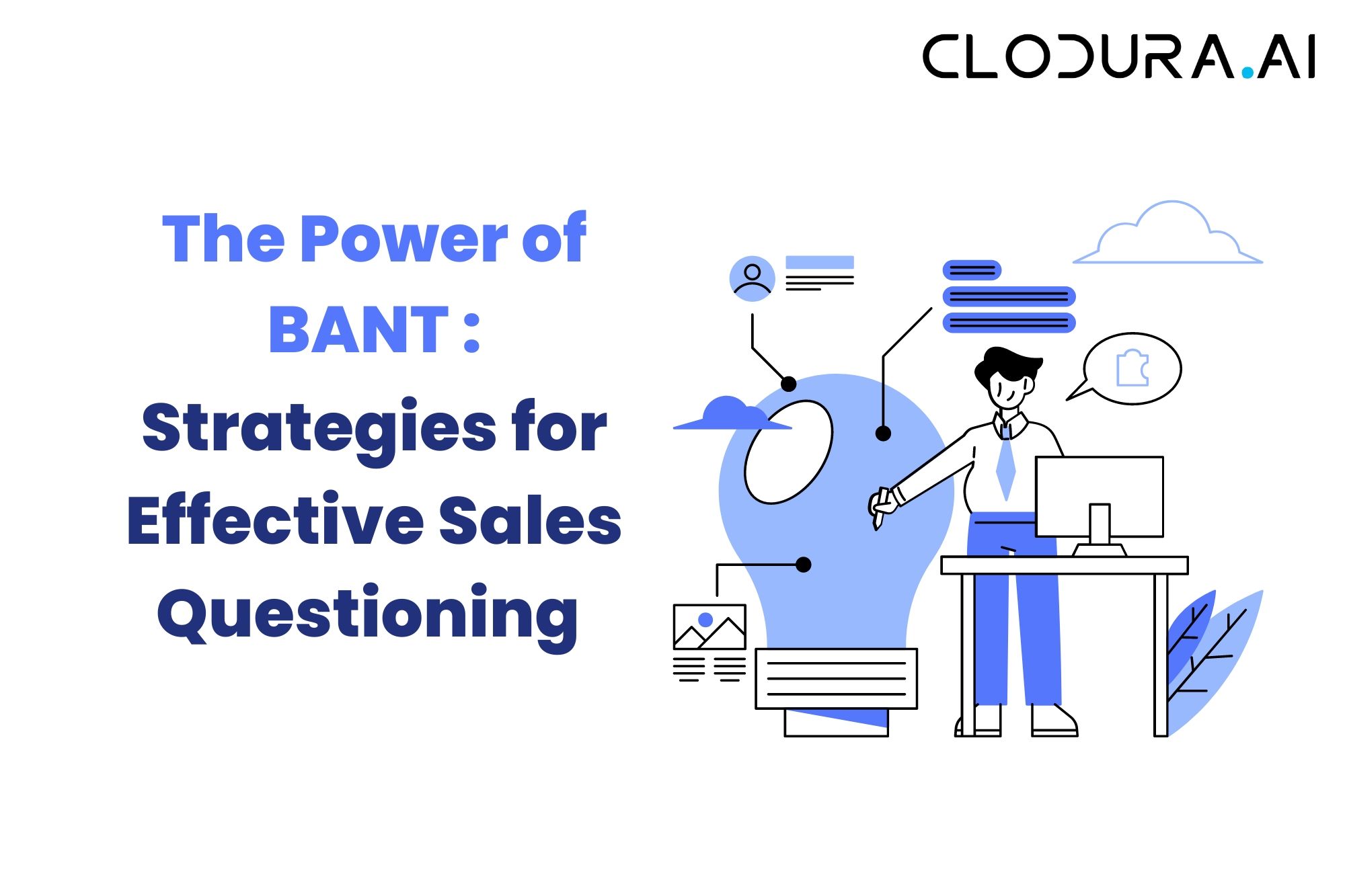Are you struggling to close sales with potential clients?
It may not be the quality of your product or service that's the issue, but rather, your approach to sales questioning.
Questions are the cornerstone of the sales process, and understanding how to craft and utilize effective questions is critical to achieving success. One framework that has gained popularity in recent years is BANT - an acronym for Budget, Authority, Need, and Timeline.
In this blog, we will explore the power of BANT and how to leverage it for successful sales.
Unpacking BANT for Sales Success
Before we dive into the strategies for effective sales questioning with BANT, it's essential to understand what each component of the acronym means.
● Budget
Budget refers to the financial resources that potential clients have available for your product or service. Understanding a client's budget is crucial for a salesperson because it helps them determine whether their offering is within the client's financial means.
It also helps the salesperson tailor their pitch to highlight the value of their product or service in relation to the client's budget.
For example, if a client has a limited budget, the salesperson may emphasize the cost-saving benefits of their offering.
● Authority
Authority relates to who has the decision-making power in choosing whether or not to utilize your offering. Knowing who has the authority to make decisions is essential for a salesperson because it helps them understand who to target with their sales pitch.
If a salesperson is pitching to someone who does not have the authority to make decisions, they may be wasting their time.
On the other hand, if they are pitching to someone with decision-making power, they can tailor their pitch to address that individual's specific needs and concerns.
● Need
Need refers to the specific problem or pain point that your product or service can address. Understanding a client's needs is crucial for a salesperson because it helps them tailor their pitch to highlight how their offering can solve the client's problem.
For example, if a client is struggling with employee retention, a salesperson may emphasize how their HR software can help the client improve employee engagement and reduce turnover.
● Timeline
Timeline is the urgency or timeframe in which the client needs the solution. Understanding a client's timeline is crucial for a salesperson because it helps them determine how quickly they need to act to close the sale.
If a client has an urgent need, the salesperson may need to expedite the sales process to ensure that the client's needs are met in a timely manner. On the other hand, if the client has a longer timeline, the salesperson may have more time to build a relationship with the client and provide additional information about their offering.
By unpacking each of these components, you gain a more robust understanding of how to craft questions that will elicit the information you need to succeed in sales. With this knowledge, you can tailor your sales pitch to address the specific needs and concerns of each potential client, increasing your chances of closing the sale and achieving sales success.
Kapil Khangaonkar, CEO of Clodura.AI, provides insights on asking BANT questions:
Understanding the 4 Criteria of BANT
Now that we have a basic understanding of what BANT encompasses let's break down each criterion in more detail.
● Budget
Budget questions are crucial in understanding the financial constraints the client may have as they relate to your offering. It's important to know what the client's budget is so that you can tailor your offering to meet their needs. If their budget is limited, you may need to offer a more affordable option or provide financing options.
On the other hand, if their budget is more flexible, you may be able to offer additional features or services that they may not have considered.
● Authority
Authority-based questions aim to identify who has the power to make the purchasing decision and who else may be involved in the selection process. It's important to know who the decision-makers are so that you can tailor your pitch to their needs and preferences.
Additionally, understanding who else may be involved in the decision-making process can help you anticipate any objections or concerns that may arise.
● Need
Need-focused questions seek to understand the client's specific pain points and how your product or service can provide a solution. It's important to understand the client's needs so that you can tailor your offering to meet those needs.
By understanding their pain points, you can position your product or service as the solution to their problems.
● Timeline
Lastly, Timeline-based questions aim to uncover the urgency or deadline for implementing a solution. Understanding the client's timeline is important because it can help you prioritize their needs and tailor your offering accordingly.
If they have an urgent need, you may need to expedite the process and provide a quicker solution. If they have a longer timeline, you may be able to provide a more comprehensive solution that takes more time to implement.
Understanding how each of these elements relates to your offering will help you craft questions that will guide the client toward a purchase decision. By tailoring your questions to their needs and preferences, you can position yourself as a valuable partner in their decision-making process.
Crafting Effective Questions with BANT
● Understand the BANT framework:
Begin by familiarizing yourself with the BANT framework, which stands for Budget, Authority, Need, and Timeline. This framework helps you qualify leads and assess their readiness to make a purchase.
● Keep questions open-ended:
When using the BANT framework, it's important to ask open-ended questions. These types of questions encourage the client to provide detailed responses and insights, allowing you to gather more information about their specific needs and challenges.
● Focus on client needs:
The primary objective of BANT-based questions is to uncover the client's needs. Tailor your questions to focus on understanding the pain points, goals, and objectives of the client. This will help you position your product or service as a solution that can address their specific requirements.
● Avoid leading questions:
Leading questions can unintentionally steer the client towards a predetermined answer or push your solution prematurely. Instead, strive to ask neutral questions that allow the client to express their thoughts and concerns freely.
● Guide the client's understanding:
Use your questions to guide the client towards a deeper understanding of their own needs. Encourage them to reflect on their challenges, consider the potential impact of those challenges, and explore how your product or service can help overcome them.
● Show value alignment:
Craft questions that highlight the value your product or service can bring to the client. Focus on the benefits and outcomes they can expect by choosing your solution. This helps establish a connection between their needs and the value your offering provides.
● Listen actively:
During the question-asking process, practice active listening. Pay close attention to the client's responses, ask follow-up questions to clarify any uncertainties, and demonstrate genuine interest in their answers. This shows the client that you are invested in understanding their needs and finding the best solution for them.

By following these guidelines, you can effectively craft BANT-based questions that facilitate meaningful conversations, uncover valuable insights, and position your product or service as the ideal solution for the client's needs.
Crafting Sales Questions that Uncover Pain Points
When crafting BANT-based questions, it's essential to focus on uncovering the client's pain points. Asking questions related to their current challenges or frustrations can help the client understand why your product or service is essential.
Be sure to frame your questions in a way that highlights the value of your offering and how it can alleviate the client's pain points.
Doing so will increase the likelihood of closing the sale.

Knowing When to Utilize BANT
While BANT is a valuable tool for sales questioning, it's not always appropriate to utilize it.
For instance, if you are selling a low-cost product or service, the budget component may not be as relevant.
Additionally, BANT works best in situations where the client has already expressed an interest in your offering. If the client is not yet aware of how your product or service can benefit them, it may be more appropriate to focus on education rather than the BANT framework.
Leveraging BANT to Build Relationships
1 Demonstrate a willingness to listen:
Utilizing BANT-based questions demonstrates that you are willing to listen and understand the client's needs. This fosters a sense of trust and respect between you and the client, which is critical for building strong relationships.
2 Understand their unique situation:
By asking BANT-based questions, you gain valuable insights into the client's unique situation, needs, and pain points. This information allows you to position your product or service as a solution that can address their specific requirements.
3 Establish yourself as a knowledgeable resource:
Through the BANT-based question-asking process, you can establish yourself as a knowledgeable resource that can provide value beyond just the sales transaction. This can help build trust and foster long-term relationships with potential clients.
4 Build trust and respect:
Strong relationships are built on trust and respect. By demonstrating a willingness to listen and understand the client's needs, you can establish a solid foundation of trust and respect that can lead to repeat business, referrals, and increased revenue.
5 Provide value beyond the sale:
The BANT framework allows you to gather valuable information about the client's needs and pain points. This information can be used to provide value beyond the sale, such as providing resources, insights, and recommendations that can help the client achieve their goals.
6 Foster long-term relationships:
By utilizing the BANT framework to build strong relationships with potential clients, you can foster long-term partnerships that can lead to repeat business, referrals, and increased revenue.
Building relationships takes time, but it is a critical component of long-term sales success.
By leveraging BANT to build relationships, you can position yourself as a knowledgeable resource that provides value beyond just the sales transaction.
This approach can help you establish trust and respect with potential clients, fostering long-term partnerships that can drive business growth.
BANT-Based Strategies for Qualifying Leads
The BANT framework can also be an effective tool for qualifying leads.
By asking questions related to budget, authority, need, and timeline early in the sales process, you can determine which leads are worth pursuing and which ones to let go.
Qualifying leads in this way saves time and resources and ensure that you're focusing your attention on those who are most likely to result in a successful sale.
Making the Most of BANT in Sales Engagements
Finally, it's essential to remember that BANT is not a one-size-fits-all solution. Successful sales questioning requires adaptability and flexibility.
While BANT provides a framework for crafting effective questions, it's crucial to tailor your questions to each client's unique situation.
Additionally, be open to feedback and adjust your questioning strategy as necessary. Doing so will ensure that you're making the most of BANT and achieving success in your sales engagements.

Gaining a Competitive Edge with BANT
Overall, the BANT framework can provide a competitive edge in the sales process.
By asking questions related to budget, authority, need, and timeline, you can gather information that will guide the client toward a purchase decision. Crafting open-ended questions that focus on the client's pain points can help establish a strong relationship that leads to repeat business and increased revenue.
While BANT may not be appropriate in every sales situation, it's a valuable tool to have in your sales toolkit and one that can help you achieve success in your sales engagements.
FAQs
Q. What is BANT?
BANT is a sales methodology that stands for Budget, Authority, Need, and Timeline. It is a framework that sales reps use to qualify leads and assess their readiness to make a purchase.
Q. What are the benefits of using BANT?
● BANT can help sales reps:
● Qualify leads more effectively
● Prioritize leads based on their readiness to buy
● Tailor their sales pitch to the specific needs of each lead
● Close more deals
Q. How do I use BANT?
To use BANT, sales reps should ask the following questions of each lead:
● Budget: What is your budget for this project?
● Authority: Who is the decision-maker for this purchase?
● Need: What are your specific needs or pain points?
Timeline: When do you need a solution?
By asking these questions, sales reps can gain a better understanding of each lead's situation and whether they are a good fit for their product or service.
Q. What are the limitations of BANT?
BANT is a valuable sales framework, but it has some limitations. For example, it can be time-consuming to gather all of the information needed to qualify a lead using BANT. Additionally, BANT can be inflexible and may not be appropriate for all sales situations.
Q. What are some alternatives to BANT?
There are several alternatives to BANT, including:
● SPIN Selling: This framework focuses on asking questions that elicit the prospect's problems, implications, needs, and solutions.
● Challenger Selling: This framework focuses on challenging the prospect's thinking and assumptions.
● Need-based Selling: This framework focuses on understanding the prospect's needs and how your product or service can meet those needs.

